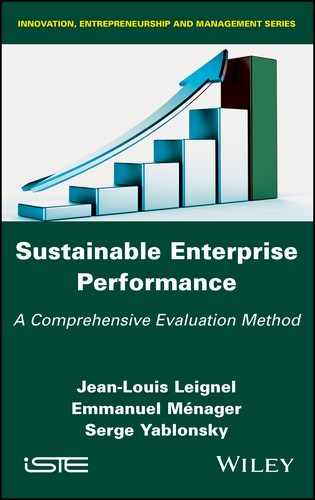Appendix
The Evaluation Questionnaire and Trends Observed
A.1. The maturity evaluation questionnaire
Based on the maturity evaluation questionnaires for sustainable performance of enterprises, l’Academie carried out an online survey among its subscribers and other firms interested in positioning themselves relative to averages.
Even if the survey cannot be considered as representative from a statistical methodology point of view, the authors consider that the results show a good average vision of French companies.
This survey relies on nine synthetic questionnaires corresponding to the four main case studies in Part 1 and the five focus area case studies in Part 2. Their goal is to initiate a very “macro” evaluation process which will serve as the “trigger” for a subsequent evaluation of continuous improvement, decided on by the enterprise.
The columns in the questionnaires correspond to the maturity level of the various criteria defined in Table A.1.
Here, we note that level 5 corresponds to a very high maturity level which is very difficult to attain, and that level 4 can be considered excellent. Level 3 constitutes a good goal, under the condition that it is achieved in all areas and not just some.
Table A.1. Maturity indicator definitions
| Indicators of maturity in terms of sustainable performance | ||
| Level | Description | |
| 1 | Non-existent | The enterprise has not yet identified the stakes of sustainable performance |
| 2 | Discovering | The stakes have been identified, but no action has been taken to address them |
| 3 | Deploying | The main executives are aware of the importance of the sustainability of performance for the enterprise’s development, and action is taken to improve the enterprise’s maturity level |
| 4 | Under control | The stakes of sustainable development are shared by the entirety of management and are formally integrated into the planning and decision-making process |
| 5 | Optimized | The enterprise has developed an approach for continuous improvement and is among the best over time |
A.2. Trends observed in French enterprises
The results of the survey, which have been summarized in Figures A.1 and A.2, range from 1.5 to 2.6 according to the considered axis, with an average of 2.2. They show that the average French enterprise has surpassed the “discovered” level and has begun to operationally deploy a certain number of good practices.
Even though these results are “decent”, they show that businesses still have a lot to do in order to improve their practices and optimize their performances in the perspective of development in the middle and long term, notably for the “strategy”, “CSR” and “ethics and compliance” axes.
In terms of strategy, the main difficulty lies within the translation of strategic objectives at the level of operational processes, management’s accountability in meeting goals, as well as the involvement of the entire workforce.

Figure A.1. Maturity evaluation of French enterprises in terms of sustainable performance along the four main axes. For a color version of this figure, see www.iste.co.uk/leignel/enterprise.zip

Figure A.2. Maturity evaluation of French enterprises in terms of sustainable performance across the five focus areas. For a color version of this figure, see www.iste.co.uk/leignel/enterprise.zip
As for CSR and ethics, the grade stems from low consideration within the enterprise’s concrete functioning for aspects concerning respect for human rights and preventing corruption as a result of new legislation in the subject area (FCPA).
The measure of the enterprise’s maturity level for each of the nine areas, and its representation in the form of radars, give a condensed but exhaustive assessment of the current situation, which allows the Executive Committee to become aware of the enterprise’s strengths and weaknesses in terms of sustainable performance.
A “macro” evaluation based on simplified questionnaires like those used in the survey are a good starting point to heighten the Executive Committee’s awareness. However, in order to launch actual improvement projects, an evaluation must then be completed with a more in-depth audit approach, which will account for the company’s environment, its line of business, any inherent risks, its size, the organization, the enterprise’s mode of management, and other factors specific to the enterprise.
This goal of this book is to contribute more broadly to making enterprises aware of the importance of envisioning performance from the perspective of sustainability, and of the many facets that management must master in order to achieve this.
